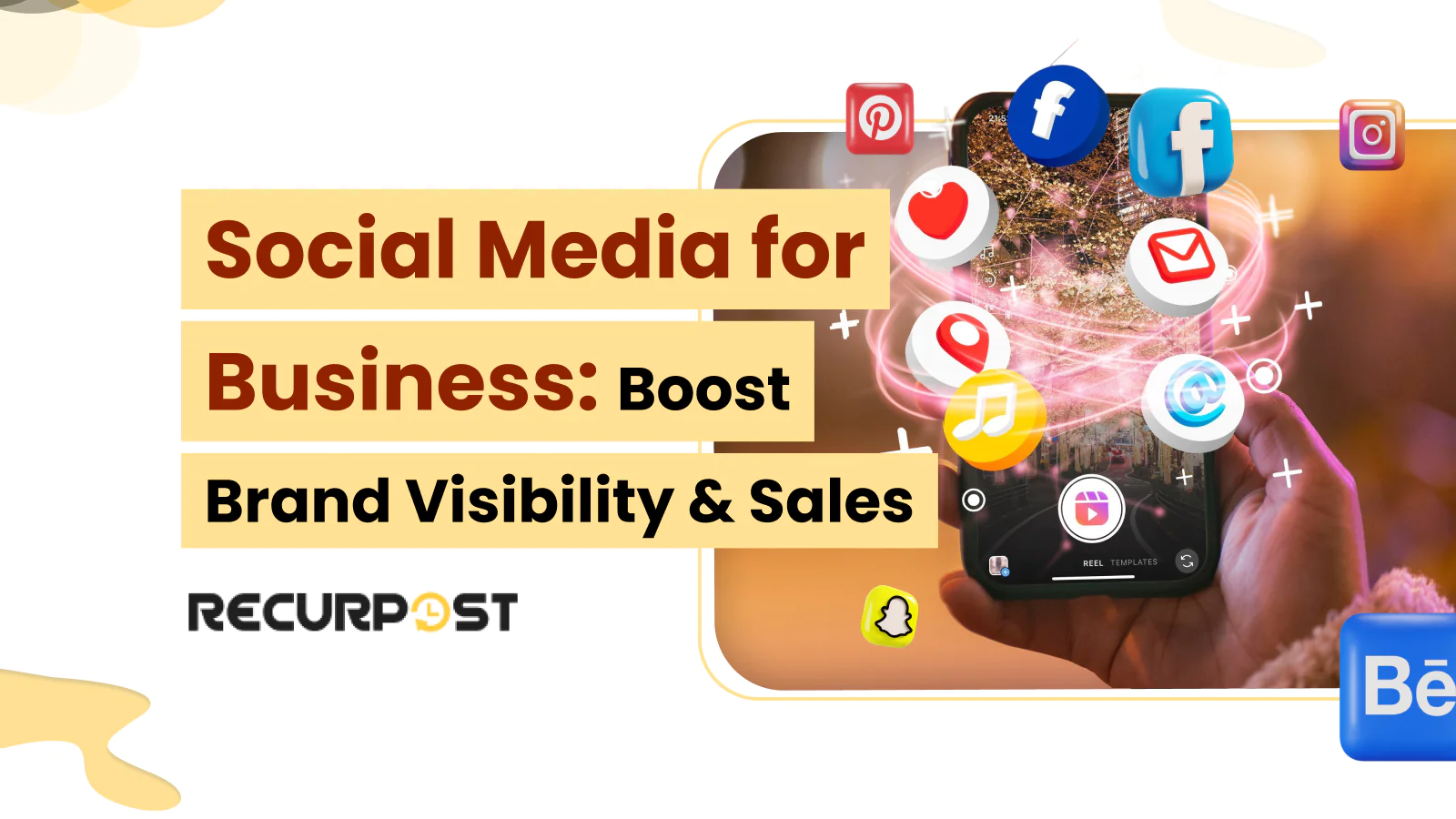Imagine spending 6 hours per week to boost your company’s visibility, traffic, and sales at no expense. Around 90% of marketers confirm social media gives businesses significant brand visibility.
Every marketing strategy includes time spent scheduling social media posts using a social media scheduler. The benefits of social media are substantial, making this low-cost marketing tool essential for businesses.
It’s clear that social media marketing is an important part of marketing success, and many marketers recognize the platform’s potential for business growth. However, some specialists remain unsure which methods deliver the best results.
According to Social Media Examiner, 96 percent of marketers use social media marketing, yet 85 percent remain unsure which techniques prove most effective. This article discusses the benefits of social media for marketing your company.
Why is social media good for businesses?

Developing an effective social media for business strategy requires both planning and creativity. Around 92 percent of marketers incorporate social media into their marketing strategies. Many businesses still don’t recognize why social media benefits their business or marketing efforts.
Nearly 40% of small businesses lack a social media presence, while 16% of respondents claim they won’t use social media for business. This creates a divide between those who grasp social media’s value and those struggling to begin. The following sections explain why social media drives business growth.
What are the benefits of social media marketing?

Social media represents one of the most efficient free platforms for brand marketing today, offering extensive reach and variety. Key benefits of social media marketing include:
- Humanize your company: You can use social media to make your company a more active player in your market. Your profile, postings, and interactions with other users contribute to a persona that your audience can get to know, connect with, and trust.
- Increase Traffic: Social media is a top avenue for driving traffic to your website, where you may convert visitors into customers, thanks to links in your profile, blog post links in your articles, and adverts.
- Generate leads and customers: Using features like Instagram/Facebook shops, direct messaging, call to action buttons on profiles, and appointment booking options, you may generate leads and conversions directly on these platforms.
- Increase brand recognition: Social media platforms’ visual aspect helps you develop your visual identity and boost brand awareness across a large audience. And increased brand recognition translates to improved performance in all of your other initiatives.
- Build relationships: These platforms allow you to engage with your followers in both direct and indirect ways, allowing you to network, receive feedback, hold discussions, and connect directly with individuals.
An engaged social media following makes achieving marketing goals more attainable.
Benefits of Social Media in Business

Social media enables business communication, marketing, and customer engagement.
When used strategically, social media’s advantages for businesses outweigh its disadvantages.
Companies leverage social media to build brand awareness, interact with customers, and enhance marketing efforts.
Social media delivers numerous benefits for businesses of all sizes, including:
- Increased Brand Visibility: Social media platforms allow businesses to showcase their products, services, and brand personality to a vast online audience. By consistently posting engaging content, businesses can increase their online visibility and reach potential customers.
- Enhanced Customer Engagement: Social media enables businesses to interact directly with their customers, respond to their queries, and build meaningful relationships. This can lead to increased customer loyalty and advocacy.
- Improved Customer Insights: Social media platforms provide valuable data and analytics that can help businesses better understand their target audience, their preferences, and their pain points. This information can be used to refine marketing strategies and product development.
- Cost-Effective Marketing: Compared to traditional advertising methods, social media marketing can be a more cost-effective way to reach and engage with customers on social media. Many social media platforms offer affordable advertising options and the ability to target specific audience segments.
Why is Social Media Important for Small Businesses?

Small businesses face unique marketing and customer acquisition challenges. Social media levels the playing field, allowing small businesses to compete with larger competitors.
Key reasons social media benefits small businesses include:
- Limited Marketing Budgets: Social media marketing can be a more budget-friendly alternative to traditional advertising, allowing small businesses to reach a wider audience without breaking the bank.
- Personalized Interactions: Small businesses can use social media to engage with their customers on a more personal level, fostering stronger relationships and building brand loyalty.
- Increased Credibility: A strong social media presence can help small businesses appear more credible and professional, which can be particularly important for new or lesser-known brands.
- Targeted Advertising: Social media platforms offer advanced targeting capabilities, allowing small businesses to reach their ideal customers with laser-focused advertising campaigns.
Why Social Media Marketing is Important for Business
Social media marketing is essential for modern business strategy. Let’s explore how can social media help business grow through these key benefits:
- Increased Brand Awareness: By consistently posting and engaging on social media, businesses can increase their brand visibility and reach a wider audience.
- Improved Lead Generation: Social media platforms can be effective channels for lead generation, as businesses can use targeted advertising and engaging content to attract potential customers.
- Enhanced Customer Relationships: Social media allows businesses to interact directly with their customers, respond to their needs, and build long-lasting relationships.
- Competitive Advantage: Businesses that effectively leverage social media can gain a competitive edge by staying ahead of their competitors in terms of customer engagement and online presence.
Why Social Media Engagement is Important for Your Business
Engaging with your audience on social media builds brand loyalty and drives business growth. Here’s why social media engagement is so important:
- Improved Customer Satisfaction: When businesses respond promptly to customer inquiries and feedback on social media, it demonstrates that they value their customers’ opinions and are committed to providing excellent service.
- Increased Brand Loyalty: Consistent and meaningful interactions on social media can help businesses foster stronger relationships with their customers, leading to increased brand loyalty and repeat business.
- Enhanced Reputation: Active social media engagement can help businesses establish a positive reputation, as customers are more likely to recommend brands that are responsive and engaged with their audience.
- Better Insights: Social media engagement provides businesses with valuable insights into their customers’ preferences, pain points, and overall sentiment, which can inform future marketing and product development strategies.
Importance of Social Media Communication in Business
Successful businesses communicate effectively, with social media becoming a critical tool for this purpose. Here’s why social media is important for business communication:
- Real-Time Interactions: Social media allows businesses to communicate with their customers and stakeholders in real-time, enabling them to respond quickly to inquiries, address concerns, and share important updates.
- Improved Transparency: By using social media to communicate openly and authentically, businesses can build trust with their audience and demonstrate their commitment to transparency.
- Wider Reach: Social media platforms have the ability to reach a much broader audience compared to traditional communication channels, allowing businesses to share their messages with a larger and more diverse group of stakeholders.
- Cost-Effective Collaboration: Social media tools can facilitate cost-effective collaboration among social media team structure, enabling businesses to improve internal social media communication in business and streamline decision-making processes.
What is the importance of Social media for startups?

Consider these facts when implementing social media for businesses:
- According to research conducted by Data Reportal, there are 4.48 billion people who use social media platforms.
- Around 73 percent of marketers feel that social media marketing has helped them grow their firm.
These statistics demonstrate how social media marketing helps startups increase sales and revenue. Main aspects of social media’s importance include:
Brand awareness
Brand recognition constitutes the most valuable aspect of social media marketing for startups. Many global firms rely on platforms like Facebook and Instagram to sell products and services.
Looking at successful social media for business examples, Clinique used Facebook ad campaigns to launch a new product line in 20 international countries, achieving a 13-point rise in ad recall and a 36-point lift in add to carts. Aside from that, 44 percent of local businesses use social media to promote their brand. As a result, they become a hotspot for marketing your company.
Direct communication
Communication forms the foundation of consumer-supplier relationships. Social media eliminates intermediaries, enabling brands to contact customers directly.
Regarding product and service searches, Google has recently surpassed social media. Customers have used social media channels to communicate with the brand in 90% of cases. Furthermore, 63% of users believe that firms should provide customer assistance through social media.
As a result, to establish brand value, you must use social media to obtain client input and resolve customer complaints.
High traffic at a low price
Companies often face resource limitations. Spending money intelligently becomes vital when designing marketing approaches. Social media marketing offers a cost-effective promotion method compared to most expensive media forms.
It saves a lot of money. Social media platforms such as Facebook and Instagram, on the other hand, charge for marketing campaigns. The advantage is that one can set his or her budget. Furthermore, if you use an organic method rather than bought campaigns, you will still get good results.
If you plan and develop your content properly, social media marketing can help you obtain a better return on investment. It will attract the people who are most likely to become customers. Ensure to incorporate and generate eye-catching visual content, as this is the most likely way to capture the user’s attention.
These reasons summarize social media marketing’s relevance for startups and small enterprises. Next, we examine practical social media for business ideas and which platforms most benefit these businesses.
A well-managed social media business presence gives startups a cost-effective method to build brand awareness, engage potential customers, and scale operations. Establishing a presence where target audiences spend time creates meaningful connections and drives growth.
Social media relevance demands attention in today’s business world. With billions of daily active users, businesses need a strong online presence to remain competitive. Social media functions as an essential tool for growth and visibility across marketing and customer service.
If you’re in the financial sector, be sure to explore our blog on Social Media for Financial Services: Best Practices & Tips for insights on how to tailor your strategy to meet industry-specific needs.
The best social media marketing platforms for business

The best social media marketing platforms for business include Facebook, YouTube, Instagram, LinkedIn, Twitter, TikTok, and Snapchat. Each platform requires different approaches based on user base, atmosphere, advantages, disadvantages, and content types.
Facebook is the largest social media platform globally and one of the biggest local business directories. People of a diverse range of age groups use it to communicate with friends and family, participate in groups and forums, find and visit businesses near them, and follow brands. Facebook is a great social media marketing platform to:
- Build relationships with current customers
- Announce hours changes, events, and milestones
- Hold discussions and live streams
- Market to baby boomers
Organic reach on Facebook is limited, so if you’re looking to generate leads or find new audiences, Facebook advertising is your best bet.
YouTube
You may not think of YouTube as a social media marketing channel, but it fits the bill: you can post videos to your channel, share, comment on, and like other videos, and follow other accounts. Plus, you have a curated feed on your homepage with recommended videos. The key to social media marketing on YouTube is not to try to “go viral,” but to add value. It’s best for:
- Tutorials, how-tos, and explainer videos
- Shoppable YouTube live streams.
- Advertising (video ads and display ads on the platform)
- SEO (video is dominating the “how to” SERP!)
Though it came onto the scene years after LinkedIn and Twitter, Instagram quickly surpassed those platforms and reached one billion monthly active users in 2018. It’s famous for its diverse content formats, including Feed posts, Stories, Lives, Reels, and IGTV. People use Instagram to follow influencers and brands they buy from and support their values. Create your Instagram bio and then use it for:
- Social shopping
- Influencer marketing
- User-generated content
- Company culture
The cost of Instagram ads is generally higher than on Facebook, but the good news is that organic reach is also higher.
LinkedIn may be a professional network, but it’s also an inspiring community that celebrates leadership, learning, and core values. So, in addition to using it to network, find prospects, and share industry insights, it’s also a great place to express your company culture and build your brand in parallel with your business brand. There are tons of Business Pages on LinkedIn features to take advantage of, so take care when making your page. LinkedIn is an excellent platform to:
- Attract top talent
- Network with partners, peers, and customers
- Share company milestones and culture
- Post industry news and insights
Twitter is a beautifully tangled network of quick thoughts, valuable tidbits, and energized discussions. You should be regularly active on every social media platform, but it’s especially important here. Many people and others use Twitter to get news, follow brands, and get customer service.. Be sure to retweet when a customer has something nice to say about you, and don’t forget to answer people’s questions when possible. For effective social media marketing on Twitter, you may want to:
- Follow influencers to keep up with news and trends.
- Share a story through a series of Tweets in one thread.
- Make yourself available for customer service and FAQs.
Snapchat
Snapchat isn’t just for teens. Its largest age group (75%) ranges from 13 to 34, and with Snap Maps, geofilters, and its partnership with Gannett, it’s more locally focused than you might think. While you can’t build relationships on the platform, you can make an audience through fun images and short videos. You can also take some Social Media Manager training and use Snapchat for:
- Location-based marketing
- App Marketing
- Feel-good content
TikTok
TikTok is the fastest growing social media platform, taking only five years to reach one billion monthly active users. While it’s known for dancing, countless popular categories on the platform continue to grow. Businesses are finding ways to use it as a marketing channel, but remember, people use TikTok for entertainment, so make sure your videos align with that. Use TikTok to:
- Participate in trending challenges
- Post funny and inspiring videos
- Be relatable
Social Media Optimization: 21 Ways to Convert Branding into Sales
How to Select the Right Social Media Platforms for Your Business
With numerous social media platforms available, choosing the right ones for your business is crucial for maximizing results while managing resources efficiently. Here are key criteria to consider when selecting social media platforms:
Audience Alignment
The most important factor is where your target audience spends their time. Research demographic data for each platform:
- Facebook reaches diverse age groups but excels with users 25-54
- Instagram and TikTok dominate younger demographics (18-34)
- LinkedIn connects primarily with business professionals and B2B audiences
- Pinterest attracts predominantly female users interested in DIY, fashion, and home decor
Business Type and Industry
Different platforms naturally align with certain business types:
- Product-based businesses benefit from visual platforms like Instagram and Pinterest
- Service-based businesses often find success on LinkedIn and Facebook
- B2B companies typically see stronger results on LinkedIn and Twitter
- Local businesses should prioritize Facebook and Instagram for community engagement
Content Resources and Capabilities
Consider your content creation capabilities:
- Video-heavy platforms like TikTok and YouTube require regular video production
- Instagram demands high-quality visual content
- Twitter works well for businesses that can create concise, timely updates
- LinkedIn values in-depth, industry-specific content
Business Goals
Match platforms to your specific objectives:
- For brand awareness, platforms with large user bases like Facebook and Instagram work well
- For lead generation, LinkedIn and Twitter often deliver qualified prospects
- For direct sales, platforms with shopping features like Instagram and Facebook are ideal
- For customer service, Twitter and Facebook excel at public and private communication
Competitive Analysis
Examine where your competitors are active and successful:
- Identify platforms where competitors have strong engagement
- Look for underserved platforms where you might stand out
- Analyze competitor content to identify opportunities and gaps
By methodically evaluating these criteria, businesses can select the platforms that offer the highest potential return on their social media investment, rather than spreading resources too thin across all available networks.
How social media helps small businesses?

A solid social media presence serves as a powerful tool for small business growth. Small business owners should maximize their social media marketing plans as these platforms revolutionize customer service. Positive aspects of social media for small businesses include:
Broader Audience
Social media is widespread. Almost half of the world’s population uses social media in some capacity. As these networks’ popularity grows, so does the potential audience for your brand to be exposed. Customers of all ages and demographics are already on social media, waiting for you to open your store!
Brand Awareness is Generated
These are the clients who are most likely to buy from you again and who can also help spread the word about your business through word of mouth. Social media attracts these clients to your company and allows you to form deep bonds with a large number of readers, all of whom can help your brand develop immensely.
Communication in both directions
Users can learn about businesses through social media, while companies may learn about their customers. A simple query in a tweet, for example, can disclose your consumers’ interests and mental processes. This data establishes the ideal foundation for a deeper relationship with your consumer base.
Support & Customer Service
These two-way communication channels enable businesses to respond quickly to any queries or concerns that customers may have. This is an excellent method to demonstrate your respect for each follower’s customer experience and guarantee that each online consumer touchpoint generates a meaningful connection with your business.
Cost-effective
Anyone can create a social media account and begin selling their product, but building a following can take months or even years. Fortunately, many social media platforms offer additional advertising packages that are less expensive than traditional ad campaigns and have a high potential for reaching a large audience.
Human Element
Small businesses may use social media to personalize their brand and form genuine connections with their customers. Showing enthusiasm for your brand and projects on social media is a great way to build a loyal following.
Collaborations with Influencers
People talk a lot on social media. However, what you truly want is for them to start talking about your company. Enlisting the support of someone with a considerable following (micro-influencers) to promote your brand on their social networks is a unique approach to getting your message out there.
Increase in Sales
Regardless of what you are selling, social media is one of the best ways to sell it. The amount of online resources available to business owners that elevate sales is astounding, making social media pages crucial elements of a company’s sales funnel builder.
How to Implement Social Media for Your Small Business
While understanding why social media is important for small businesses is essential, knowing how to actually implement it is equally valuable. Here’s a practical approach to get your small business started with social media:
- Start with a clear strategy: Define your goals, target audience, and key performance indicators before creating any accounts. Determine what success looks like for your business—whether it’s increased website traffic, lead generation, or brand awareness.
- Choose the right platforms: Rather than trying to maintain a presence on every social network, select 2-3 platforms where your target audience is most active. For B2B companies, LinkedIn and Twitter often work best, while retail businesses might focus on Instagram and Facebook.
- Create a content calendar: Plan your content at least two weeks in advance, mixing promotional posts with educational and entertaining content. Aim for an 80/20 ratio—80% valuable content and 20% promotional material.
- Allocate resources wisely: Designate specific team members to manage your social media or consider hiring a part-time specialist if budget allows. Even dedicating 5-6 hours per week can yield significant results.
- Use scheduling tools: Leverage tools like RecurPost to schedule and automate your posts, saving time while maintaining a consistent posting schedule across platforms.
- Monitor and engage regularly: Set aside time daily to respond to comments, messages, and mentions. Social media is a two-way conversation, not just a broadcasting channel.
- Track results and adjust: Use platform analytics to track performance against your goals and refine your approach based on what resonates with your audience.
Small businesses that follow these implementation steps typically see meaningful results within 3-6 months of consistent effort.
How to Maximize social media’s impact on your business?

Social media positively affects organizations and allows audiences to find you online. It enables contact with your target group, maintains connections, and facilitates quick question responses. Monitoring competitors’ social media profiles provides valuable competitive analysis.
Social media creates beneficial outcomes for organizations regarding brand awareness, consumer engagement, revenue, and customer support. It also reveals how competitors use social media to grow their businesses. Here are major positive impacts of social media on organizations:
#1. Your Omnichannel Customer Service Takes on a New Dimension!!
Customers prefer communicating with brands through social media for immediate responses. Studies show 42% of clients expect social media responses within 60 minutes.
Customers who contact you through social media sites like Facebook, Twitter, LinkedIn, Instagram, and Whatsapp will receive a seamless omnichannel messaging experience if you engage them through social media.
A company’s ability to provide omnichannel customer service is critical. However, using the correct tools and systems to assist your company in creating an omnichannel experience across the customer lifecycle is even more critical.
#2. Effect On Website Traffic
Many people devote a significant amount of time to social media. Globally, there are expected to be over 2.77 billion social media users by 2019, up from 2.46 billion in 2017.
As a result, it’s an excellent way to generate traffic to your website. Furthermore, because social media supports various formats, you can attract more visitors to your website by sharing text, photographs, videos, podcasts, and other media.
Social media is a wonderful medium since it allows users to effortlessly share their postings, allowing your company to reach many people in different time zones. The important thing to remember is that social media directly impacts your website’s traffic. So here are some ideas for getting your brand out there to provide customer assistance through social media.
Here are some suggestions and social media management tips for promoting your business.
- Check to determine if your target group is already present on social media networks before going up there. It’s not a good idea to blindly follow other brands.
- Use beautiful visuals and content to catch initial attention and enhance interaction once you’ve segmented your target.
- Start a conversation – Engage in social media by listening and participating in amazing conversations by tagging or mentioning others.
- Measure your efforts – It’s critical to track your social interaction using external technologies. Improve your brand’s image by gaining knowledge, focusing your efforts, and improving your brand’s image.
- Check out the best days to post on social media.
Best Practices to know why social media is essential for business:
- Determine your target demographic, trends, and behaviors, and then select your company’s appropriate social media outlets.
- Social media is a great area to connect and give your brand a voice. Make sure your tone is consistent, welcoming, and appropriate for the company you’re promoting.
- Content that is both visually appealing and engaging is essential. Ask questions, conduct polls, and hold events to generate relevant, high-quality material and engage your audience.
#3. Social Media Allows Collecting First-Hand Customer Feedback
Customers can provide first-hand feedback through social media platforms, which can help improve the brand’s image, reputation, and customer relationship. The consumer must feel heard and valued for them to be satisfied.
As a result, respond to every post, criticism, and suggestion and make the best of it for your brand’s growth. Businesses who use social media to respond to customer service demands earn 20 percent to 40 percent more revenue per customer.
This will demonstrate your commitment to offering a memorable experience and ensuring that no client feedback goes forgotten. You may also drive accurate business results by monitoring social media using customer feedback tools.
Best Practices to know why social media is important for business:
- You should respond even if the person hasn’t explicitly tweeted at you or requested assistance. You’re paying attention when you respond to brand remarks or comments.
- Retweet a pleasantly resolved support encounter to promote your clients. It’s as if you’re thanking your customers profusely.
- Give your customer care representatives a public persona. Use a team photo or an agent spotlight, for example. It’s wonderful to link the brand’s beginnings and the people who created it.
- After a successful interaction, ” “How is everything?” is a good follow-up question.
#4. Generate Leads Directly & Indirectly
Most marketers and business owners are aware that social media is an excellent tool for allowing people to learn about and even understand a brand. Still, it can also be an excellent source of leads, both directly and indirectly. It seems self-evident, but it is much too often disregarded. Make it as simple as possible for customers to convert on all of your brand’s social media platforms.
As social media platforms have matured, they have become increasingly effective at generating leads, with most media ultimately including obvious calls-to-action on company pages, posts, and more. However, it’s simply a matter of time if the platform hasn’t yet progressed toward a network’s paid/marketing part. Every day, new ideas for generating leads emerge.
Facebook, Instagram, and Snapchat have all updated their platforms to make it easier to display CTAs for brand accounts where businesses may advertise their products and services. As a result, actual sales from within the platform are now more widespread than ever. In addition to the typical Follow and Message buttons found on most accounts, social media networks have added various CTAs to profile landing pages.
#5. The New Marketing is Social Customer Service
Most companies focus on customer service. Social media offers a unique way to improve service, satisfy customers quickly, and maintain two-way communication.
Let’s take social media management examples, imagine you manage Whatsapp, which is the most used customer care channel worldwide. According to the data, over 1.5 billion monthly active users send and receive over 60 billion messages per day, demonstrating a high level of platform activity.
According to the company, Whatsapp’s Business app enables enterprises to “interact with customers seamlessly by leveraging technologies to automate, organise, and quickly answer messages.”
#6. Social Media Can Be a Growth Tool’s Driving Force
Brands’ social media interaction with their customers can boost conversion rates. A proactive approach to social media marketing will boost a brand’s marketing strategy. Twitter is an excellent example of how this can be accomplished. According to MediaBistro, 67 percent of Twitter users are likelier to buy from companies they follow. In addition, 42% of consumers use Twitter to find out about products and services they are interested in.
This type of outreach should not be ignored. Best practices include for why social media is important for business are:
- Using concentrated social media listening to understand more about what’s going on in your industry.
- Engage in social selling activities.
#7. Social Media Increases Brand Loyalty
“A brand represents a customer’s loyalty and trust.”
Developing and retaining brand loyalty is crucial for businesses. You may use social media to build relationships with your customers, which increases loyalty and advocacy. The following are some of the reasons why brand loyalty is so important:
- Resistance to competition – In this competitive market, brand loyalty is difficult to come by. Customers have numerous options available to them, which might cause them to become dissatisfied rapidly. Your brand’s perception attracts new customers, but committed customers provide genuine value.
- Meaningful interaction – Loyal social media followers are more inclined to interact with your posts and start meaningful conversations. Genuine interest is more significant to your online image.
- Brand advocacy – Loyal social media followers are likely to become brand champions. Even if they aren’t persuaded, they will talk highly about your brand.
Developing brand loyalty ensures long-term engagement over social media. Research shows that 66% of users between 18 and 24 years old are more loyal to the brands they follow on social media. Best practices:
- To keep up with your competitors, you should develop an inventive social media strategy that includes a cohesive approach.
- Share high-quality content to build brand loyalty. Visual content attracts a lot of attention. So, to make content more appealing, use infographics, movies, screenshots, graphs, etc.
- Ensure that you are not ignoring exchanges, as followers prefer humanized connections over bots or social media automation content.
#8. Social Media Marketing (SMM) is Economical
Many businesses are hopping on the Social Media Marketing (SMM) bandwagon because it benefits brands and, when done correctly, promises economic success. Social media marketing methods target social networks and applications to increase brand visibility.
Because social media marketing is perceived as a more focused type of advertising, it is incredibly effective at increasing brand awareness. Social media engagement programs can generate a lot more shares, views, and visibility for your organization for a one-time price. The following topics are frequently addressed in social media marketing campaigns:
- Creating a presence on major social media platforms
- Content that can be shared and advertorials
- Using surveys and contests to solicit client feedback throughout the campaign
One person who shares or retweets a message from your company might reach hundreds, if not thousands, of people for free! Businesses who miss out on this opportunity due to non-engaging social media strategy are squandering a significant opportunity.
To comprehend the reason why social media is important for business, follow these prescribed procedures:
- If you’re a startup or a small firm, social media marketing can help you grow while saving money.
This takes us to why social media is important for businesses, and finally, we conclude our article on why social media is important for businesses.
To maximize social media’s impact on your business, it’s important to understand the distinct roles that contribute to a successful strategy. A Social Media Manager and a Community Manager both play critical roles but with different focuses. Understanding these key differences helps you allocate resources effectively and ensure that both strategic content creation and community engagement are handled proficiently.
Measure Social Media ROI for Your Business
Understanding the return on investment from your social media efforts is essential for justifying resources and optimizing your strategy. Here’s how to effectively measure social media ROI:
Define Clear Objectives
Before measuring ROI, establish specific, measurable goals for your social media presence. These might include increasing website traffic, generating leads, driving sales, or improving customer retention. Each objective requires different metrics for measurement.
Track Relevant Metrics
Depending on your goals, focus on these key metrics:
- Awareness metrics: Reach, impressions, follower growth, and brand mentions
- Engagement metrics: Likes, comments, shares, and click-through rates
- Conversion metrics: Lead generation, email sign-ups, and direct sales
- Customer value metrics: Customer retention, satisfaction scores, and support issues resolved
Implement Proper Tracking
Use these tools to accurately track social media performance:
- UTM parameters to track traffic from social platforms to your website
- Conversion pixels to monitor actions taken after clicking on social media content
- Promotional codes specific to social media campaigns to track direct sales
- Customer surveys to determine how social media influenced purchasing decisions
Calculate Actual ROI
The basic formula for calculating social media ROI is:
(Value Generated – Cost) ÷ Cost × 100 = Social Media ROI (%)
Value generated includes both direct revenue and indirect benefits like increased customer lifetime value or reduced customer service costs. Costs include platform advertising, content creation, management tools, and staff time.
Analyze Beyond Direct Conversions
Remember that social media’s impact extends beyond immediate sales. Consider its contribution to:
- Shortening the sales cycle
- Increasing customer retention and loyalty
- Reducing customer acquisition costs
- Building brand equity and recognition
By systematically measuring social media ROI, businesses can make data-driven decisions about where to allocate resources and how to optimize their social media strategy for maximum returns.
Conclusion
Social media marketing for startups or small businesses presents challenges on multiple levels. Reach limitations, targeting difficulties, and budget allocation with poor results can create obstacles.
With proper experimentation and continual efforts, businesses achieve necessary results from social media marketing. Those persistent with social media receive compensation reflecting their hard work and consistency in building a strong online presence. Beyond creating a social media marketing strategy, proper implementation requires following through with proposals using appropriate tools.
You might also be interested in knowing how to manage multiple social media accounts.
Frequently Asked Questions
1) How many people use social media?
According to the most recent statistics, there were 3.96 billion social media users globally in 2023, up 4.8 percent over the previous year. It’s also 1.1 billion greater than the number of social users in 2017, a 38.5 percent increase in only six years.
2) Why social media presence is important for business?
You may use social media to develop every area of your brand. Advertise: You may utilize targeted advertising on social media to grow your business. In 2024, this is a major advantage! As we go towards a more streaming-heavy culture, the value of radio commercials and tradiional television ads is dwindling.
3) How do startups use social media to sell themselves?
Startups need to put more effort into content generation because they have yet to discover what engages their audience the most on social media. Startups can hire a professional staff to design social media content calendar and synchronize content creation with graphic aspects. Using analytics, they can then share these posts using a scheduling tool and track their social media performance.
4) Why is advertising on social media important?
Advertising on social media is crucial for businesses to stay relevant in present times. It helps brands reach their target audience, drive traffic, and increase conversions. The relevance of social media in business ensures companies remain competitive and connected to their customers.
5) What is the impact of social media on small businesses in 2025?
Social media impacts small businesses in 2025 by enhancing brand visibility, enabling direct customer engagement, and driving sales growth, which has led 77% of small businesses to use these platforms for key business functions including marketing, sales, and customer service. Platforms like YouTube, Facebook, and Instagram allow small businesses to reach millions of users with engaging content, build stronger relationships through real-time interactions, and create new revenue streams.

Debbie Moran is a Digital marketing strategist with 5+ years of experience producing advertising for brands and helping leaders showcase their brand to the correct audience. She has been a part of RecurPost since 2019 and handles all the activities required to grow our brand’s online presence.
